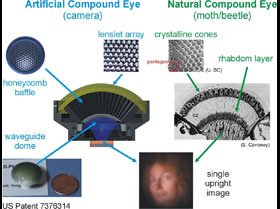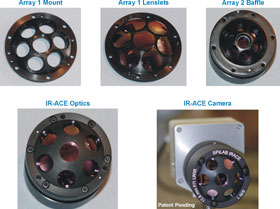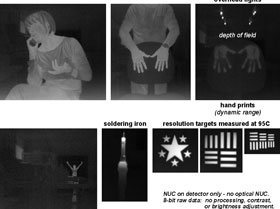Artificial Compound Eyes
Artificial compound eyes (ACE) are new types of cameras inspired from the architecture of natural compound eyes. Natural compound eyes can be divided into two general categories: apposition and superposition. The apposition eye contains simple lenslets that focus light onto nearby receptive rods called rhabdoms. Each lenslet and rhabdom constitutes an ommatidium, of which there are thousands in a 3D spherical array format separated by light absorbing pigmentation. Each ommatidium detects only a small cone of light entering along its central axis. The out-of-field light is either absorbed in the pigmentation or detected by the adjoining lenslets viewing the adjacent fields. The resulting image mosaic appears erect and contiguous.
The superposition eye replaces the lenslets with elongated crsytalline cones, and a clear zone separates the cones from the light sensitive rods. The cornea of each crystalline cone focuses the incoming light within the cone, and then the latter part of the cone collimates the light. Each cone therefore acts as both a Keplerian telescope objective and an afocal eyepiece. The array of cones form a meniscus shaped structure with a common nodal point. Therefore beams of light that enter the cones at the same field angle converge toward the same spatial point when they exit the cones. Multiple field angles result in multiple convergence points, which together form an image on the convex shaped rhabdom layer. Since light from hundreds of cones contribute to each field point in the image, the effective sensitivity of a superposition eye is increased relative to an apposition eye. This is why superposition eyes are found primarily on nocturnal arthropods, such as moths, and apposition eyes are found primarily on diurnal arthropods, such as butterflies.
SPILAB developed the first refractive, artifical superposition eye in 2005. A cross-sectional view of it is shown in the diagram on the left, alongside a disected beetle eye. The natural crystalline cones are replaced by two molded glass lenslet arrays. The light absorbing pigmentation is replaced by a honeycomb louver baffle, which is manufactured using a UV curable inkjet 3D layering process called Polyjet. The baffle channels the ommatidium light and blocks ghost images. The beams of light that pass correctly through the baffle tubes converge to form a spherically shaped image. This curved image is captured by a mushroom shaped waveguide dome consisting of millions of optical fibers fused together. The waveguide dome transfers the curved image onto a CCD array bonded to the small, flat end of the mushroom. The resulting image is upright and contiguous. No signal processing is required to generate this image.
SPILAB began developing infrared artificial compound eyes (IRACE) in 2010. The IRACE lens arrays are formed from chalcogenide glasses that can be hot press molded. However, the lens arrays for the test prototype, shown on the left, were created from diamond turned lenslets mounted in aluminum preforms. The first IRACE images, shown to the right of the camera hardware, were captured using a 640 x 512 pixel micro-bolometer array.



